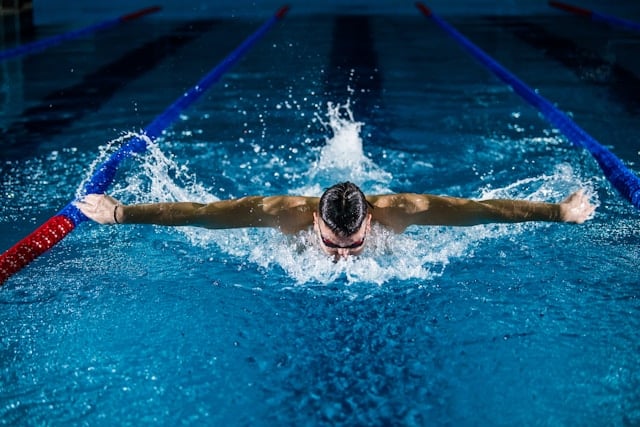Swimming is an all-encompassing exercise, engaging the cardiovascular system and working multiple muscle groups simultaneously. It requires not only strength and endurance but also the right technique to execute each stroke efficiently. One crucial component of swimming that often gets overlooked is breathing. Proper breathing can significantly enhance your swimming performance, especially in distance swimming where stamina is key.
Understanding the Importance of Breathing in Swimming
Before diving into the best breathing techniques, let’s first understand why it’s so vital in swimming. A swimmer’s relationship with air is quite different from that of athletes in other sports. The water environment imposes constraints on when and how often you can breathe, making it a challenging but essential element to master.
A lire en complément : What Are the Best Practices for Pre-Season Conditioning in Collegiate Football Linemen?
Breathing affects all parts of your swim. For instance, the way you take in and expel air impacts both your body position in the water and your swim rhythm. A well-timed, efficient breath can keep your body balanced and streamlined, minimizing drag and enabling faster, more effortless strokes.
Furthermore, breathing influences energy levels. Oxygen powers our muscles, so the more efficiently you can get it into your body, the less likely you’ll experience fatigue, thereby improving your endurance over long swims.
A lire également : How Can Mixed Martial Arts Fighters Safely Cut Weight Before a Bout?
Breathing Techniques in Freestyle Swimming
The freestyle stroke is the most popular and quickest stroke in swimming, often used in distance swims. Breathing technique plays a significant role in maintaining speed and endurance in freestyle swimming.
Bilateral Breathing
Bilateral breathing involves inhaling every three strokes, allowing you to breathe on both your left and right sides alternately. This technique aids in maintaining balance in the water, preventing you from favoring one side and potentially developing a lopsided stroke.
Bilateral breathing also gives you a 360-degree view of your surroundings, useful in open-water swimming where it’s essential to sight landmarks or buoys.
Breathing Every Two Strokes
This breathing technique is where you breathe every two strokes on the same side. It allows for a higher frequency of oxygen intake, which may be beneficial in maintaining stamina during long distance swims. However, be cautious as this technique could lead to an imbalance in your stroke if not done correctly.
The Importance of Head Position in Breathing
The position of your head when you breathe significantly impacts your overall swimming efficiency. Incorrect head position can lead to poor body alignment and increased resistance in the water.
Neutral Head Position
Keeping a neutral head position is vital when you are not taking a breath. Your gaze should be directed downwards and slightly forward. Imagine a line extending from your head down your spine – this line should be as straight as possible.
Breathing Position
When you turn to breathe, your head should rotate along with your body, not lift upwards. Only a small portion of your face (one eye and half your mouth) needs to be above the water to get a good breath. Your head should quickly return to the neutral position once you’ve taken a breath.
Training the Breath for Stamina in Distance Swimmers
As distance swimmers, training your breathing specifically for endurance is paramount. This isn’t just about technique; it’s also about increasing your lung capacity and oxygen efficiency.
Hypoxic Training
Hypoxic training involves workouts that limit your oxygen intake, training your body to use oxygen more efficiently and increase your lung capacity. This can be as simple as reducing the frequency of your breaths during swim workouts.
However, hypoxic training should be approached with caution and preferably under the guidance of a qualified coach. Without proper supervision, it can lead to unsafe drops in oxygen levels.
Breathing Exercises
Dryland breathing exercises can significantly improve your breath control and lung capacity. These include activities like yoga and meditation, where you focus on controlling your breath, or fitness exercises that involve high-intensity intervals with short recovery times, forcing your body to recover quickly between bursts of effort.
Breathing well is a skill just like the perfect stroke. It requires practice and patience to master, but the rewards make it worth the effort. With the right techniques and training, you can enhance your stamina, improve your swimming efficiency, and take your distance swimming to the next level. Remember, the breath is your ally in the water, not your enemy – harness it, and you’ll unlock your true swimming potential.
Mastering the Breathing Rhythm in Distance Swimming
One of the many aspects that sets swimming apart from other sports is the obligatory requirement to establish a rhythmic breathing pattern. This pattern goes beyond simply inhaling and exhaling. It’s a cadence that must synchronize seamlessly with your strokes, contributing to the overall efficiency of your swim.
In distance swimming, particularly in the freestyle or front crawl stroke, the rhythm of your breathing can make or break your performance. The goal is to find a pattern that allows you to consume the maximum amount of oxygen without disrupting your stroke efficiency.
Many swimmers adopt either a two-stroke or a three-stroke breathing pattern. A two-stroke pattern involves breathing on one side only, while a three-stroke pattern, also known as bilateral breathing, involves alternating breaths between both sides. Each has its own benefits and drawbacks, and the choice often depends on the swimmer’s preference, the race distance, and the open water conditions.
Two-stroke breathing allows for a higher rate of oxygen intake, which can be beneficial in maintaining stamina during long swims. However, it may lead to an imbalance in your stroke and body position if not executed properly.
On the other hand, bilateral breathing aids in maintaining balance in the water and gives you a 360-degree view of your surroundings, a critical advantage in open water distance swimming. It allows you to maintain equal strength and technique on both sides, but it provides less frequent oxygen intake.
Ultimately, what’s important is to find a breathing rhythm that suits you and stick to it. Consistency is key. Constantly switching your breathing pattern can disrupt your stroke rhythm and waste energy.
Lung Capacity and Breath Holding in Swimming
In distance swimming, having a large lung capacity and good breath control can be a significant advantage. The larger your lung capacity, the more oxygen you can take in with each breath, increasing your efficiency and endurance in the water.
One way to increase lung capacity is through hypoxic training, where you limit your oxygen intake to train your body to use oxygen more efficiently. However, this should be done under proper supervision to avoid unsafe drops in oxygen levels.
Another method to enhance your lung capacity and breath control is through breathing exercises. These exercises can be done on land and involve practices like yoga, meditation, or high-intensity interval training. They help train your lungs to take in more air and your body to use it more efficiently.
Breathing exercises also play a crucial role in managing your heart rate during a swim. A faster heart rate consumes more energy, which can lead to quicker fatigue. Through controlled breathing, you can help maintain a lower heart rate, preserving your energy for those long swims.
Conclusion
Mastering the art of breathing in distance swimming is no easy task. It requires dedication, practice, and a keen understanding of your body. But when done right, it can significantly improve swimming performance, helping you swim faster, longer, and more efficiently.
Remember that the perfect breathing pattern, body position, and breathing technique vary from swimmer to swimmer. What’s important is finding what works best for you and sticking to it. Incorporate practices such as bilateral breathing, breathing exercises, and lung capacity training to help improve your stamina and take your distance swimming to the next level.
Swimming is a journey of constant learning and improvement. So keep refining your strokes, tweaking your breathing patterns, and always be open to learning. As you harness the power of your breath, the water will seem less like a barrier and more like a home. Happy swimming!











